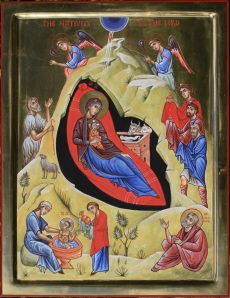The Quest for the Ordinary
It has been many years since Garrison Keillor trekked to the studios of Minnesota Public Radio at Saint John’s. In my first years in the monastery, Keillor was a familiar figure on our campus, and a Prairie Home Companion was a daily event. Back then the sponsors were a bit more eccentric, but consistent through the years has been the character of Lake Wobegon, the mythic town which neighbors Saint John’s. Then, as now, all the women were strong, all the men were good-looking, and all the children were above average.
I used to think that this must be an exceptional place, until I recently recalled its sister-city in New England, Stepford. In Stepford all the women are lovely, all the children are obedient, and all the men are heavily bruised from pinching themselves all day. Then the light bulb came on, and I began to wonder if average people are an endangered species in America. If they aren’t yet, they will be soon. The overabundance of superlative grandchildren argues that in our lifetime the average kid will go the way of the polar bear.
No business, no institution and no person wants to be thought of as merely average any more. You need only look at the ubiquitous persuit of excellence to realize where we are headed. Universities have Centers for Excellence in Everything, and companies have eighteen-point plans to achieve excellence in the mail room. Excellence is the buzz-word which drives us all, and it will continue to do so until someone points out that excellence has become the new Gentleman’s C. Then we will all stampede in pursuit of some new fantasy of self-delusion.
 The fact of the matter is, we are a people obsessed with image, and in the pursuit of persona we are subject to the same inflationary spiral that sometimes bedevils the economy. To cite but one example, there was a time when a young actress aspired to be a starlet. Then “star” became de rigueur. But one glance at the award shows reveals that it is the superstars that radiate above the galaxies of stars. What’s next? So far only Dame Edna has staked a claim to Megastar, but you see where this is headed.
The fact of the matter is, we are a people obsessed with image, and in the pursuit of persona we are subject to the same inflationary spiral that sometimes bedevils the economy. To cite but one example, there was a time when a young actress aspired to be a starlet. Then “star” became de rigueur. But one glance at the award shows reveals that it is the superstars that radiate above the galaxies of stars. What’s next? So far only Dame Edna has staked a claim to Megastar, but you see where this is headed.
Given all this hoopla over excellence, has the Church made a terrible mistake when it begins Ordinary Time on January 10th? Is it not demeaning to invite an entire population of overachievers to live in ordinary time? Just hours after Saint Valentine has banished Saint Nicholas from the stores, and when the Easter Bunny is only days away from hopping down the bunny trail, has Christianity once again failed to stir the imagination?
In his Rule for Monasteries, and in his biography by Gregory the Great, it is the ordinary which seems to grab Saint Benedict’s attention. He doesn’t schedule any big Christmas bashes; and as for Lent, he writes that our entire lives should be a Lenten obsevance. While he certainly is aware of the cycle of seasons and the liturgical year, it’s the daily grind that transforms us. It’s the task of seeing Christ in one another, on the weekdays, that is life’s biggest challenge. It is the monotony of showing up for prayer and work, day in and day out, that is far more taxing. That’s what really tests the metal of the monk. It’s on those days when we see any real progress in the spiritual life; while the feasts are merely the bookends in life.
So what should be our resolution for Ordinary Time? I would contend that it is the ordinary which is most important. It is in the ordinary that we see the hand of God stirring the pot, whether it be in our neighbor or in the routine of our lives. To discount these moments in favor of the few super-blowout-days in the year is to miss the greatest gifts God has in store for us.
But what about the pursuit of excellence? Well, I for one have chosen to exit from the overcrowded highway to excellence. In 2012 I’ve set my sights on nothing short of eminence.
Monastery notes
Today, January 9th, marks the last day of the Christmas season, no matter what the malls may have said last week. By sunset the trees in the monastery will be down, and the decorations will once again be in storage. The three magi will have made their visit to the new-born savior, and many of us will begin our atonement for the cakes and candies that modern magi have brought.
On January 2nd, the feast of Saints Basil the Great and Gregory Nazienzen, I celebrated the Abbey Mass. While Basil in particular was an important influence on Saint Benedict, I opted to preach on the gospel of the day from John 1: 19-28. You may read that sermon, Who are you? John the Baptist’s Response, in Presentations.
During the Christmas holidays we began a new book in the Abbey refectory: Bill Bryson’s A Walk in the Woods: Rediscovering America on the Appalachian Trail. For those unfamiliar with Bryson’s work, I’m happy to say that you have some wonderful reading ahead of you. I had already read this book, and before that I had gone through two others by Bryson: The Life and Times of the Thunderbolt Kid: A Memoir; and I’m a Stranger Here Myself: Notes on Returning to America after Twenty Years Away. From my perspective his dry wit and spare writing style are nothing short of hilarious at times. While Saint Benedict discourages laughter in the monastery, one evening the reader choked on his own laughter, and soon most of us yielded to uncontrolled laughter. At that point the abbot rang the bell, and that was the end of table reading for that evening. I recommend Bill Bryson highly, but merely for your reading pleasure and not for your spiritual edification.
Years ago someone ruined my Christmas holiday by giving me Ken Follett’s Pillars of the Earth. I spent all of my free-time reading it, only to emerge bleary-eyed for church and for meals. I spent this Christmas in 18th-century Russia, reading Robert Massie’s new book, Catherine the Great. I had enjoyed two of his previous books: Peter the Great, and Nicholas & Alexandra, and this book is equally fascinating. When a German-born empress (Elizabeth) names her German-born nephew (Peter) her heir, and then marries him to a German-born wife (Catherine), you logically assume that you would not be in Russia. Wrong. Though Catherine did close several hundred monasteries, that’s as close as this book comes to the topic of monastic spirituality. But if you want to be glad you’re alive today, read this terrific book.



